Page settings are designed to give the document the desired appearance. This is relevant for creating almost any document - from a contract or order, to a fiction book or scientific work. Knowing how to change margins and being able to choose the optimal paper size and page orientation for a particular document, you will be able to format documents correctly and beautifully and save yourself from unnecessary routine work.
Setting Page Options
Page parameters are set immediately before formatting and placement of various objects on it. You can set these parameters at the end of working on the document, but keep in mind that, for example, with large field values, appearance document may change significantly. Page parameters are most comparable to the foundation of a building, and therefore should be set first, because all alignments in the document are tied to the page orientation and its margins. You can also configure settings in general or by category.
Document fields
Document fields can be quickly customized using ready-made templates. Go to the Page Layout tab - click the Margins button and select one of the margin options.
If you need to manually configure the fields, do the following:
- “Page Layout” - in the “Page Setup” group, click “Margins” and in the window that opens, click “Custom Margins”. The “Page Setup” window will open on the “Margins” tab;
- In the margin position areas, specify their size, the size of the binding in the “Binding” area, and the position of the binding in the area of the same name;
- Click the icon to open the Page Setup dialog box when open tab"Page Layout" in the "Page Setup" group.
Figure 1: Setting up fields in different ways.
Page orientation
To set the page orientation:
- “Page Layout” tab - in the “Page Setup” group, click the “Orientation” button and select the desired option;
- “Page Layout” - “Page Setup” group - click on the icon for opening the “Page Setup” dialog box and select the one you need in the “Orientation” area;
- Double click on the ruler.
Figure 2. Changing the page orientation.
Paper size
- “Page Layout” - in the “Page Settings” group, click the “Size” button and select one of the 13 available templates.
For finer tuning:
- “Page Layout” - group “Page Options” - “Size” - “Other Page Sizes”;
- “Page Layout” - in the “Page Setup” group, click on the icon to open the “Page Setup” window and go to the “Paper Size” tab;
- Double click on the ruler - "Paper Size" tab.
Figure 3. Selecting paper size.
Page Setup Window
The Page Setup window has three tabs: Margins, Paper Size, and Paper Source.
Figure 4. Tabs of the Page Setup window.
Fields Tab
In the “Fields” area, set four document fields. For standard official documents, the margin values are equal: left - 2.5 cm (1 inch), right - 1.25-1.5 cm (about half an inch), top and bottom 1.5 - 2 cm (in some documents the bottom margin is larger than the top) , and the maximum margin values are equal: for the left one - 3cm, for the rest - 2cm.
In the "Binding" list, select the location of the binding - left or top. Binding is often used in the preparation of brochures, calendars, and directories, but as a rule, it is not specified in ordinary documents.
If you need to place two documents vertically within one document, open the list and in the “Multiple pages” field and select “2 pages per sheet”.
When working with double-sided documents, use mirrored margins. In this case, the left and right margins are automatically swapped on odd and even pages. To do this, in the “Pages” area, in the “Multiple Pages” field, select “Mirror Fields” from the drop-down list.
In the Sample area, in the Apply drop-down list, select an option to apply the changes.
- “To the current section” - changes made are applied only to the current section;
- “To the end of the document” - from the highlighted space to the end of the document. If you change the margin size, for example, it will only affect the pages within the selection margin;
- “To the entire document” - changes will be applied to the entire document.
Paper Size Tab
In the Paper Size area, you can select given size paper format - A4, A3, A5, etc.
In the “Height” and “Width” fields, set an arbitrary size.
In the "Paper Feed" area, you select how paper will be fed for printing. It is recommended to use the default values.
The Sample area is similar to the one described above.
Paper Source Tab
In the “Section” area, in the “Start Section” field, you can select where the next section will begin.
In the "Page" area, you can select the alignment:
- "Align Top" is the default and is the most commonly used setting;
- “Centered” - lines of text will be aligned to the center of the document, and the text will be filled evenly from the center, up and down;
- “Aligned to height” - there is a certain similarity with aligning text to width, only in this case the lines are aligned to the height of the page. The fewer lines on the page, the greater the distance between them;
- “Align Bottom” - lines are aligned to the bottom of the page. Often used in letters and prologues to fiction novels.
In the "Differentiate Headers and Footers" area, you can set the distance to the header and footer, and how the headers and footers will differ - by the first page or by even/odd pages. Headers and footers will be discussed in more detail in future articles.
Default values
If you work with the same document type all the time and need to use the same page settings, set default values. Go to the Page Setup window and set the parameters you are looking for, then click the Default button and confirm your selection. These settings will be applied to all subsequent documents until the next time changes are made.
Conclusion
After reading this article and following a number of simple steps, you will be able to effectively customize the appearance of your document even before you start typing. This will come in handy when working with almost all documents. What's more, you'll be able to save yourself the hassle of adjusting margins and paper size, or at least you'll know to prioritize page settings when you first start working on your document. Knowing how to configure page settings will be useful to anyone who works with documents.
Page Options in Word Office since 2007 appear in a separate menu tab. The menu design has changed significantly since this year's version, and many users spent significant emotional effort when switching to it. But after a while, changing page parameters and other design elements no longer caused confusion.
In preparation text document you have to adjust the size of the page that the computer feeds to the printer, sometimes change the orientation of the pages, and almost always change the margins of the document.
Fields
In order to change document fields you need to click on the “Margins” button in the tab called “Page Layout”. This will display possible field options, including the field widths set the last time you used the program. You can select from the proposed options or set new values; to do this, you need to find “Custom fields” at the very bottom of the list. When you click on this inscription, the “Page Settings” window opens.
Page orientation
In the window that appears, you can change the field width values. Here it also changes page orientation"landscape" or "portrait". Changing the page orientation is sometimes necessary when you have to insert large tables oriented like a landscape sheet into a document.
Paper size
In the same “Page Settings” window are installed And paper sizes, only this can be done in the tab of the same name. Here you can find standard paper sizes and set them for the entire document or individual pages.
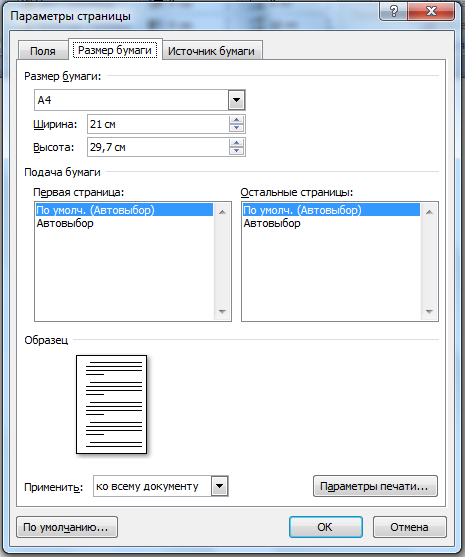
In order to change the settings for individual pages, you need to select the text on this page and then open the “Page Settings” window. In the appropriate tab, change the parameter and indicate at the bottom where it says “Apply” “to the selected text.” In this way, you can change the sheet size, margin, and orientation of the paper.
To quickly change the orientation and size of pages, the corresponding buttons are installed directly in the “page layout” panel. It should be noted here that changing the orientation of individual sheets rather than the entire document only possible through the following path: fields/custom fields. Where you need to select the appropriate orientation and specify: apply to selected text.
Columns
If the text needs to be displayed in columns, then in the “Page Layout” tab there is a button “ Columns", by clicking on which you can select up to three columns and adjust their sizes and the size of the spaces between them. This can also be applied either to the entire document or to selected portions.
Hyphenation
In the same tab you can do , Moreover, Word 2007 makes it possible to do this automatically and manually, as well as change the parameters of their arrangement.
Home tab
Document formatting also requires compliance with such parameters as: line spacing, paragraph indentation and text alignment on the page. It turns out that many people still do this as if typewriter, that is, using the space bar.
Paragraph
For these settings, you need to go to the “Page Layout” tab, open the “ ” dialog box by clicking on this icon. In the window that opens, set the required parameters: line indents, first line indents ( paragraph indentation), line spacing and spacing between paragraphs.
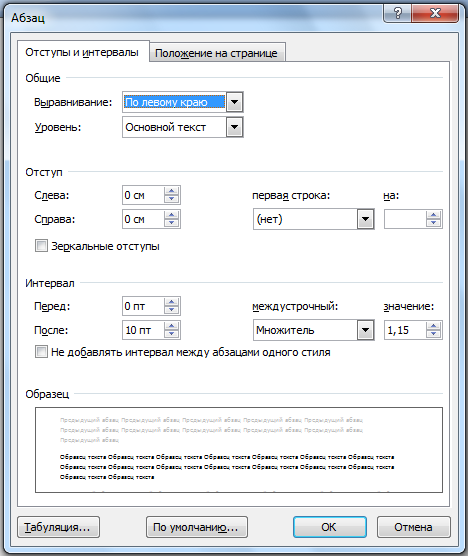
This is how you can configure page settings and other document design settings in Word Office. This describes how to work with the tools menu in the 2007 version.
Word Page Options -
This paper size, page orientation, Word margins, wrapping words Word,
etc. Word Page Setup feature located on the "Page Layout" tab. Buttons for frequently used functions are located in the "Page Options" section. But by clicking on the arrow at the bottom right of the "Page Setup" section, you can open the "Page Setup" window, in which you canMore functions where you can set your page parameters.
"Fields" button.
Fields in Word- This is the indentation of text from the edge of the page. They can be customized - reduced, enlarged, removed completely, so that the text can be printed from edge to edge of the page, etc.
On Word pages The standard text indentation from the edge of the sheet (margin) is set. On the right, this indentation is wider so that when stapling a printed document and attaching it to a folder, the text will not be covered.
You can change the size of the field, separately for the top, separately for the bottom, left, right.There is a “Fields” button for this purpose.Click on this button and, from the list that appears, select right size fields.
If we want to set our own field size, click the “Margins” -> “Custom Fields” button. A dialog box will open and, in the “Fields” section, configure each field separately. Below in the dialog box we look at the example for changes.
Also, fields can be adjusted in view mode or in normal mode you can move the ruler.
Remove fields in Word.
You can completely remove all fields. Then the text will be placed to the very edges of the page.
How to do different fields on different pages Word document(for example, a form on both sides), see the article “Different fields in one Word document”.
Orientation button
in the "Page Settings" section- unfolds the sheet. Will make it portrait orientation or landscape. 
Word's Page Setup will help you create the desired look for your document. With them you can change the page orientation, margins, etc. Let's figure out how to find and open these same “Page Options” in Microsoft Word.
We will perform all manipulations in the program Microsoft Office Word 2013, but these functions are no different in Microsoft Word 2010 and Microsoft Word 2007. In Microsoft Word 2003, you simply click on File and select Page Setup.
In Word 2013, 2010 and 2007 you need to do the following:
1. Go to the “Page Layout” tab.

2. Click on the arrow located below.

3. A window with Word page parameters opens.
In the "Fields" section you can:
- Change margins: top, bottom, left, right, binding, binding position.
- Select orientation: vertical or horizontal; either portrait or landscape.
- Select page options.
- Apply the selected settings to the entire document or to individual pages.
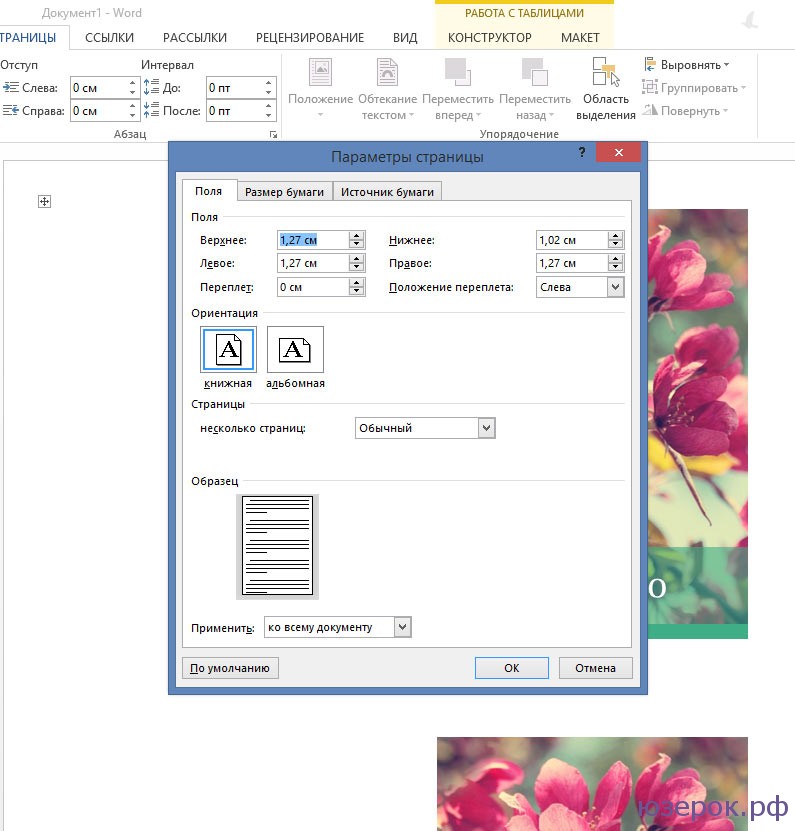
In the Paper Size section you can:
- Select paper size: A4, A3, etc., select width and height.
- Set the paper feed (first page and remaining pages).
- Apply to the entire document or not.
- The Print Options button is also available here.
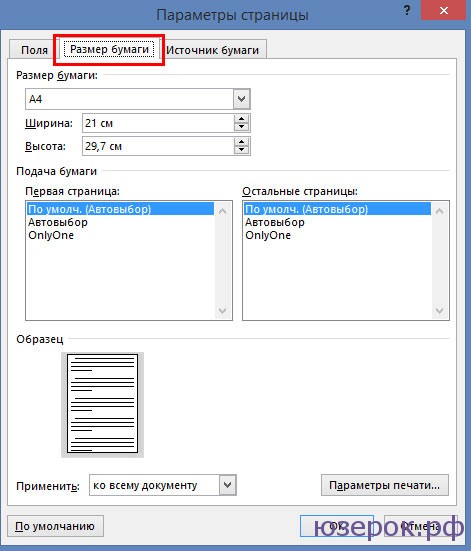
In the "Paper Source" section, you can make the following settings:
- Select a section.
- Set header and footer values.
- Do the alignment.
- Number lines in Word.
- Make boundaries.

After you have made all the page settings settings in Microsoft Word 2013, Microsoft Word 2010, Microsoft Word 2007, click “Ok”.
Page parameters should be understood as its key characteristics, which determine the placement of text and other objects on it. These may include fields, dimensions, orientation.
Fields determine the edges and boundaries of an area of text that enclose it within itself. Dimensions adjustable height and width. Orientation means its location in relation to the reader. This article will discuss the features of adjusting parameters in Microsoft versions Office 2003, 2007, 2010. In addition, we will describe the word wrap setting.
Page settings
To set these settings in Word 2003 you need to go to the menu File And choose item of the same name. In version 2007 and later you need to go to the menu Page layout and click on the arrow located below.
Page Margins
A dialog box allowing you to change fields in Microsoft Word 2003 will appear after clicking Page settings in the above manner. Its approximate appearance is shown in the photograph. Thus, in this window we install dimensions top, left, bottom and right margins, binding. Change if desired book orientation towards landscape and vice versa. These changes can be applied to the entire document or to its current page.
In version 2007 and higher everything is installed similar way.
Paper size
The size can be set if necessary print document on a sheet with a format different from A4 sheet. Latest installed default. It is important that the paper size is supported by the printing device. As you can see from the screenshot below, the program user is trying to set the A5, A6 or B5 format. For his convenience dimensions indicated each type of paper.
It is also possible to install printer settings. Adjusts the paper feed and, like margin settings, the settings apply to the entire document or to the current position. For ease of selection, a sample sheet of paper to be printed is shown in the window. 
In Office 2007 and higher, the size is adjusted using a different sequence of steps:
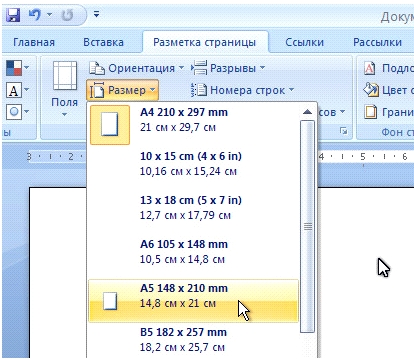
Columns
As a rule, texts are written from one column, but there are situations, say in newspapers or magazines, when they are written in several columns. Sometimes this is relevant when filling websites with content.
The number of columns in the 2003 version is selected as follows:
- Select the menu at the top of the window Format;
- Then click on the item Columns;
- A window will appear;
- Choose quantity columns, their width and scope.
Can be applied to the entire document, or to the end of the document. 
When working with Office 2007 or 2010, we act differently. Need to go to the menu Page layout. Then select the item Columns. Here it is configured number speakers and their location. They can be moved left or right. 
Hyphenation
In Word 2003, the word wrap setting is done like this;

If the text has already been typed and you need automatically make transfers, then a marker is placed in the appropriate field. If you need to transfer abbreviations or other words from in capital letters, then the appropriate one is selected setting. If necessary, adjust the distance from the last character to the right edge, make changes to the item Latitude of transfer zone. If desired, you can use forced method. 
In the 2007 version, the setting is done differently. First you need to go to the mentioned markup menu and select the command Hyphenation. If you select Auto, then they will arrange themselves. At manual options will offer options for hyphenation in the selected word. The decision is made by the person. To select special settings, use the command Hyphenation options. These are similar to the options in Word 2003. 
Page orientation.
Working with the package from 2003, we go to the already familiar item with fields from the menu Page settings. There will be two orientation options: book And landscape. The current orientation will be highlighted with a frame. To change it, you need to check a different box. 
It can be applied as to the entire document, so until the end of the document. For the first option, select the appropriate item. When working with a package from 2007, to change orientation you need to go to the menu Page layout and select item Orientation. The same options will be offered.
